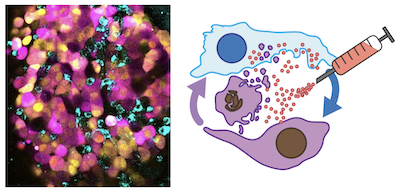Miller Lab
Read BioLaboratory for Synthetic and Spatial Tissue Dynamics
Our team seeks to understand how molecular & cellular signaling dynamics are spatially controlled in tissue, and how they can be therapeutically manipulated to treat disease.
We focus on inflammation and cancer, and combine an interdisciplinary toolset to shed light on multicellular regulation within disease microenvironments. New nanomaterial and synthetic biology technologies enable our studies using in vivo imaging and network-level computation.
Our interdisciplinary approach benefits from close collaboration — including with other groups in CSB — to successfully marry computational analyses with appropriate experimental measurements and models of disease. We acknowledge funding from the NIH Common Fund, the NIH National Cancer Institute, the Department of Defense, the American Thyroid Association and the Thyroid Cancer Survivors’ Association, Inc., among others.
We are actively growing our team in all project areas and are considering applications on a rolling basis. For enquiries, please send CVs to miles.miller@mgh.harvard.edu.
Recent Publications
Zhao P, Kundu J, Blanton D, Rezaeeyazdi M, Oudin MJ, Miller MA, Meyer AS, Bencherif SA, Baranov PY, Young MJ, Carrier RL
Human Retinal Progenitor Cell (hRPC) Migration in Three-Dimensional (3D) Environments of Varying Stiffness and Composition. J Tissue Eng Regen Med. 2025;2025:9963972 - PMID: 41195017 - PMCID: PMC12585844 - DOI: 10.1155/term/9963972Rodriguez-Castellanos VE, Quintana JM, Martin JM, Goemans MA, Banla LI, Ng TSC, Weissleder R, Miller MA
Radiation-Triggered Payload Release Enhances Bispecific Antibody Efficacy. Cancer Res. 2025;:ePub - PMID: 41066595 - DOI: 10.1158/0008-5472.CAN-25-0517Simpson GG, Quintana JM, Carrothers JE, Jiang F, Walker SA, Cho C, Weissleder R, Miller MA, Ng TSC
Fluorescent PSMA-Targeted Radiotheranostic Compounds for Multiscale Imaging. Bioconjug Chem. 2025;36(7):1448-1460 - PMID: 40574660 - PMCID: PMC12365983 - DOI: 10.1021/acs.bioconjchem.5c00139Obuchi W, Zargani-Piccardi A, Leandro K, Rufino-Ramos D, Di Lanni E, Frederick DM, Maalouf K, Nieland L, Xiao T, Repiton P, Vaine CA, Kleinstiver BP, Bragg DC, Lee H, Miller MA, Breakefield XO, Breyne K
Engineering of CD63 Enables Selective Extracellular Vesicle Cargo Loading and Enhanced Payload Delivery. J Extracell Vesicles. 2025;14(6):e70094 - PMID: 40527733 - PMCID: PMC12173531 - DOI: 10.1002/jev2.70094Di Ianni E, Jeon J, Hu H, Quintana JM, Lee C, Haidar EA, Mohammadi S, Zargani-Piccardi A, Mahamdeh M, Hernández IC, Ng TSC, Breyne K, Lee H, Breakefield XO, Miller MA
Enhanced mRNA delivery using ultrasound-delivered click reactive anchors. bioRxiv. 2025;:ePub - PMID: 39975219 - PMCID: PMC11838329 - DOI: 10.1101/2025.01.28.635330- More publications ...
Research projects
Image-guided cellular reprogramming in cancer

A growing and largely descriptive single-cell atlas of tissues has begun providing insight into the spatial organization of microenvironments, yet it remains a challenge to understand cause-and-effect relationships from such data. How does the signaling state of one cell affect that of its neighbors? We aim to address this question by leveraging advances in in vivo imaging, nanotechnology, and synthetic biology to generate a framework for image-guided manipulation, real-time monitoring, and systems-level analysis of signal propagation. Although this project will yield fundamental insights into signaling propagation, we also aim to extend image-guided genetic reprogramming to therapeutic applications.
Nanomaterials for localized therapy

Thousands of biomaterials and nanoparticles have been developed for drug and nucleic acid delivery, but molecular and cellular-level mechanisms of their action in tissue are often poorly understood. Our group expands on novel in vivo imaging techniques to analyze the combined distribution and action of biomaterials and nanoformulations at a multi-scale level. This project pursues a systematic, molecular-level understanding of drug action, with the goal of informing improved therapeutic and biomaterial designs.
Multi-scale dissection of tumor microenvironment dynamics

Through new technologies, including single-cell RNA sequencing (scRNAseq) and multiplexed tissue imaging (MTI), tissues can now be visualized with incredible molecular and cellular detail. However, such rich maps of tissue structure are typically static snapshots from a fixed sample, and lack important information about how the tissue actually functions — how cells, fluids, and biomolecules dynamically interact to govern multicellular behaviors. This project aims to overcome this limitation by building an integrated computational and experimental platform for quantitatively linking functional dynamics within tissue to a map of its molecular and cellular composition.